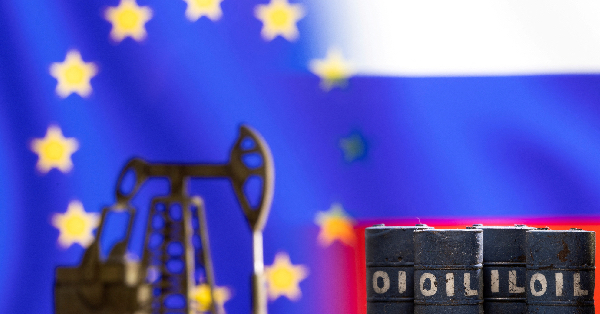European Union countries are nearing a deal to cap the maritime trade of Russian crude oil at $60 per barrel, building upon an initiative by the Group of Seven (G7) to further weaken the Kremlin’s ability to wage war on Ukraine. Ambassadors have spent several days engaged in an intense debate over how high or how low the price cap should be, trying to strike a balancing act between the need to impair Russian revenues and avoid any abrupt disruption in global markets.
Poland and the Baltic states adopted a hard-line stance and pushed for a strong limit, going as far as $30 per barrel, while Greece, Cyprus and Malta, whose domestic shipping industries play a key role in the international transport of Russian oil, demanded a $70 cap, diplomats with knowledge of the situation told Euronews. Negotiations tried to find a middle ground between the two sides, with a draft compromise of $62 per barrel, which was still deemed excessively high by the Eastern European group. The talks also focused on enforcement, transparency and a potential new package of EU sanctions. On Thursday, consensus settled on $60 (€57) per barrel, diplomats said. A final deal is expected to be reached on Friday, as other countries await Poland’s green light. “There is a 99% chance,” said an Eastern European official. “It’s only a matter of time.”
Russia, however, is already selling its Urals crude oil at a discounted price, which has in recent weeks ranged between $77 and $64 per barrel – about $20 cheaper than the benchmark Brent crude oil. Under the plan, Russia will lose the difference between the commercial price and the capped price. The limit will be regularly reviewed according to the evolution of the energy sector. Once endorsed by the G7, the cap will enter into force on 5 December, the same day the EU’s own ban on Russian oil is scheduled to take full effect, a move that will remove millions of barrels from the market. The price cap will work as a ban to provide key services: the G7, the EU and Australia will prohibit their banking, insurance, flagging and shipping firms from working with Russian companies that sell crude oil at a price that exceeds the $60 cap.
Western countries hold a dominant position in these services and believe Russia will not be able to fully replace them if it refuses to comply with the price cap. Given the untested nature of the measure, it remains unclear how many viable substitutes Russia can find outside the Western sphere to keep its fossil fuel industry running smoothly. Nevertheless, the impact will be felt: the sale of fossil fuels is Russia’s main source of revenue, representing over 40% of its federal budget. From the start of the war on 24 February to 28 November, Moscow has earned over €116 billion from sales of crude oil and €38 billion from oil products and chemicals, according to numbers provided to Euronews by the Center for Research on Energy and Clean (CREA), a Helsinki-based organisation.
The European Union was the largest buyer across this period. But the situation will soon change: 5 December marks the final deadline for EU countries to phase out all imports of Russian seaborne crude. Two months later, on 5 February, they will be compelled to do away with all refined petroleum products. The EU embargo introduced a total prohibition on providing services to Russian oil tankers. This provision will now be softened to allow the servicing of Russian companies that respect the G7 cap. Both measures – the EU ban and the G7 cap – are intrinsically linked: as the EU removes itself as a top client of Russian oil, the global market will see a disruption in the delicate supply-demand balance, which the price cap is supposed to help cushion.
Officials in Brussels admit the cap has to tangibly hurt Russia but also allow it to reap a minimum level of profits so that the country keeps trading its products around the world. There is also concern the measure, if not properly calibrated, might backfire, trigger an abrupt spike in oil prices and alienate Asian and African countries against the West. The $60-per-barrel cap will be regularly revised to ensure it remains synchronised with market trends and takes into account Russia’s economic situation. According to a pre-war estimate by International Monetary Fund (IMF), Russia needs to sell its oil at a price between $30 and $40 per barrel in order to recoup all production costs, including transportation, extraction and development of new wells. “It is plausible that the sanctions introduced since the start of the war have significantly increased (these costs),” an IMF spokesperson told Euronews.
Source: Euronews









































